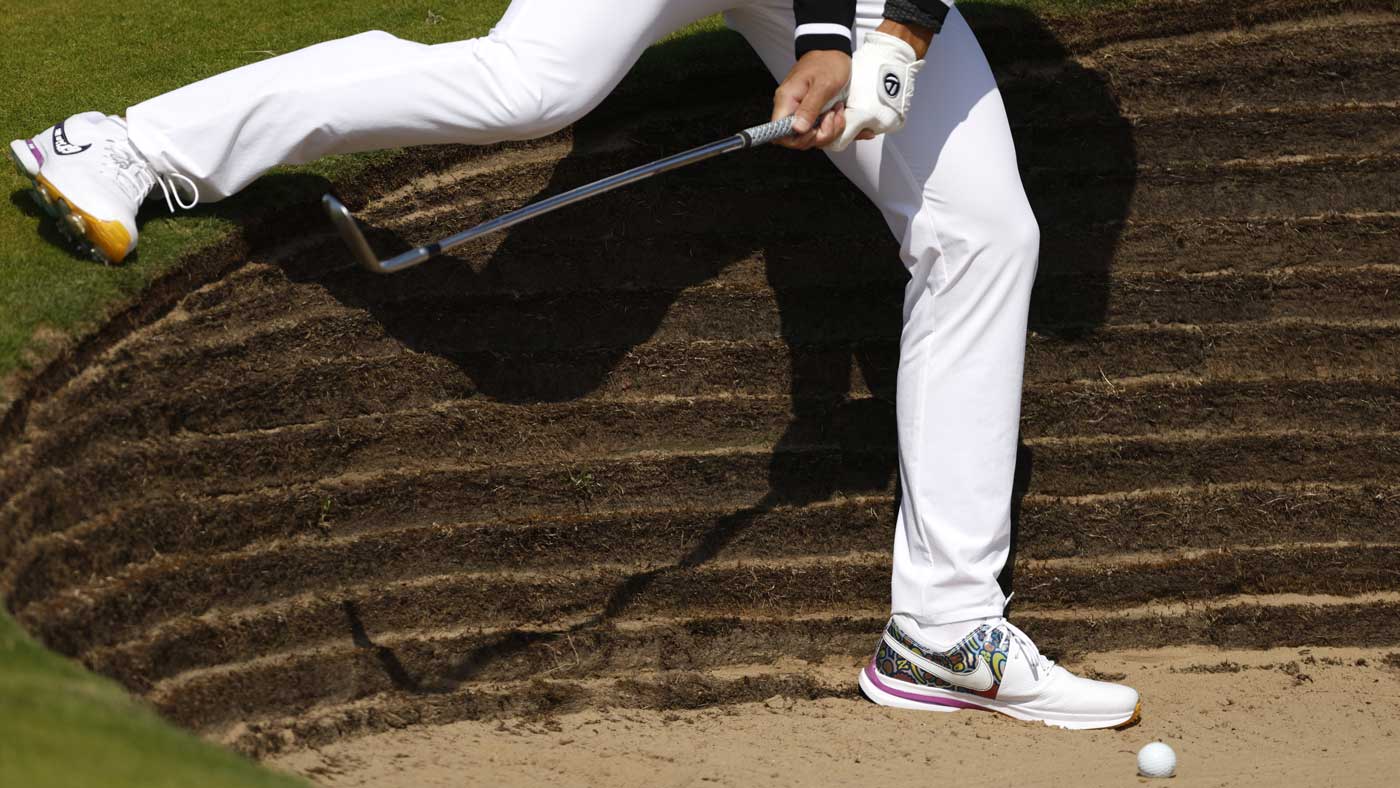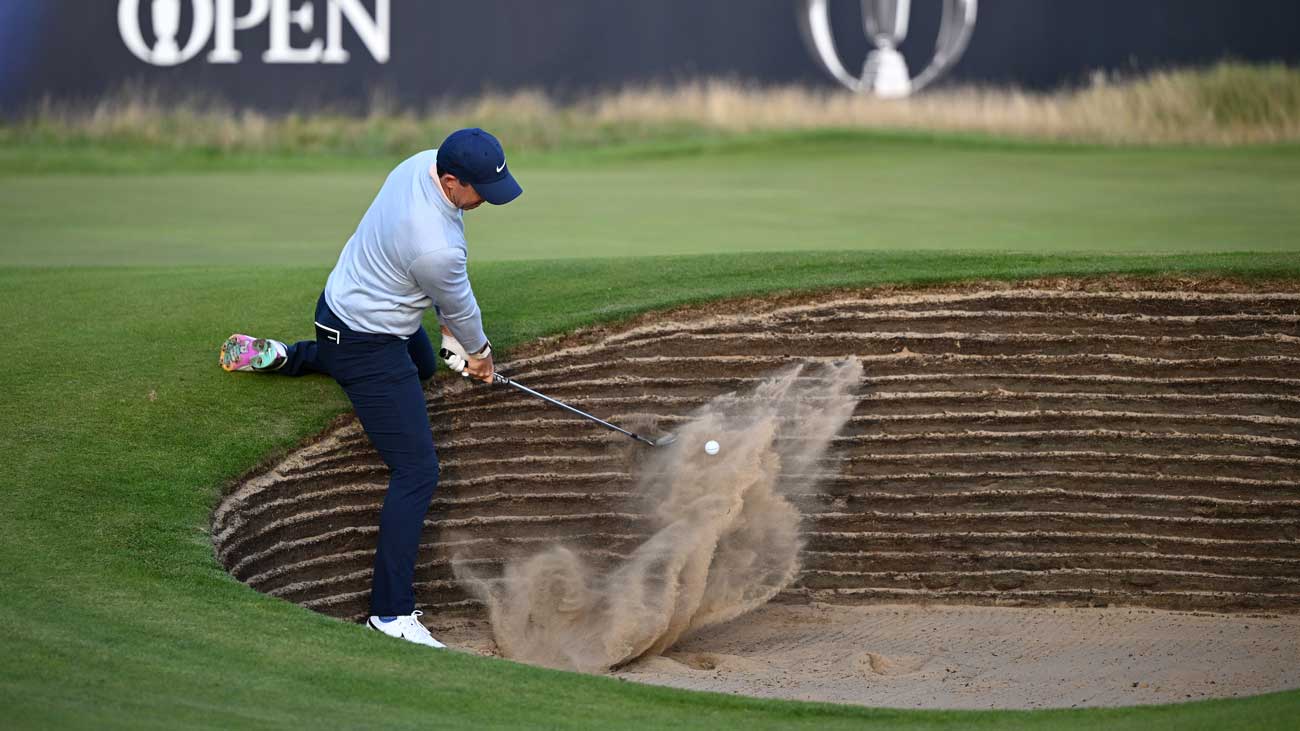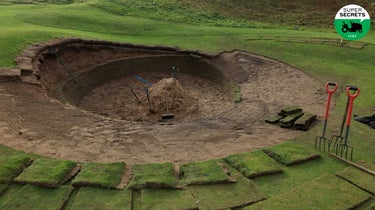
Keita Nakajima of Japan playing a bunker shot on the 4th hole in the first round.
getty images
When the Royal & Ancient’s setup czars made the call to partly defang Royal Liverpool’s daunting pot bunkers before the second round of the 151st Open Championship, it was a decision most players undoubtedly embraced, even if it didn’t register with all of them.
“Not familiar,” Zach Johnson said when asked about the move; this was following a second-round 69 that had moved him to two over for the week.
A reporter explained to the U.S. Ryder Cup captain that in the wake of the first round — when balls regularly trundled into the bunkers and settled within a couple of inches of the revetted sod walls, making extraction a mighty, sometimes impossible, task — the R&A elected to make the pits less penal by raking the sand toward the walls, in effect creating a ramp that would push balls back toward the center of the bunkers and give players more room to operate. The R&A’s official notice read, in part: “Yesterday afternoon the bunkers dried out more than we have seen in recent weeks and that led to more balls running straight up against the face than we would normally expect.”
“They made an announcement?” Johnson said, beginning to smile. “I probably should have read that.”
Johnson’s inattention to tournament alerts wasn’t the only explanation for his obliviousness. He was among the lucky few who largely avoided the bunkers Friday, so he had few opportunities to inspect them.
“I think I only hit it in one sand trap or bunker, fortunately,” he said.
Other players were less fortunate, meaning by the end of the second round, most of the field had had a chance to form an opinion on the R&A’s unexpected about-face.
Like Johnson, Rory McIlroy was unaware of the new raking protocol when his second round commenced. But when McIlroy knocked his second shot into a greenside pot bunker on the par-5 5th, the gentler, kindler slopes quickly became apparent to him.
“I was pleasantly surprised that I had a shot,” he said, adding, “I wouldn’t say there’s one person in the field that wouldn’t welcome that change.”
Perhaps, but there was at least one player who had mixed feelings: Scotsman Richie Ramsay.
Ramsay, who got wind of the setup tweak not by way of a formal player notice but on social media, said he not only noted that the sand was fuller at the base of the walls Friday but that it also might have been too full.
On the par-4 16th hole, he said, he hit a 4-iron into the breeze that found a greenside bunker — and a plugged lie. He had to pitch out backward, leading to a double-bogey 6. Two holes later, at the par-5 18th, he said he hit a 3-wood downwind with his second shot that flew into a greenside bunker “like a missile.” That ball also plugged, in the middle of the bunker. Ramsay said he couldn’t tell if his shot had run up to the wall and then trundled back into the unfortunate lie, or if it had simply buried in that spot.
“Two just shockers, really,” said Ramsay, who signed for a one-over 72 to drop him to three over for the week. “I don’t know if that’s an anomaly or I don’t know if that’s something that’s a regular occurrence. You’ve just got to try and take the hit, but obviously I wasn’t that pleased [with] 16 and 18 to say the least.”
As ever with major-championship setups, striking a balance between challenging and unfair is a high-wire act. It’s true of green speed and fairway width and rough length, but rarely is there as much scrutiny on bunkers as there has been this week in North West England. Matthew Jordan, who is a member of and the course record-holder at Royal Liverpool, knows these bunkers as well as any player in the field.
After a second-round 72 dropped him back to one under, he called the R&A’s decision “probably worthwhile,” but added, “I think we all want to see them as hazards, don’t we? We don’t want to see people hitting in there, getting perfect lies and flicking them out. It’s just hard to get a balance between — I had a couple yesterday which were just unbelievable. I’ve never seen that around here before. I think that was probably the right decision, but at the same time, I’m all for them being hazards.”
Of the plugged lies Ramsay encountered, Jordan said: “Yeah, I think one thing that is happening is if the ball flies in, it’s flying in hard, it’s hitting up the face, and then because of —it’s not that steep, and there is a bit of sand there, so it’s just coming up and then coming down and semi-plugging, which isn’t great. I don’t know how the guys are preparing, but it’s just a difficult one, isn’t it, to get right? I think they’re close.”
Leave it to Jordan Spieth to offer one of the more nuanced takes on the situation. In the first two rounds, Spieth managed to mostly avoid the bunkers, so he didn’t spend much time analyzing their severity. But, he said, he did understand why the flat bases can be problematic, if not borderline unfair.

getty images
“You have these downwind par-5s where you can hit really, really nice shots into greens the way that they ask you to play them,” he said. “And then they can end up essentially — maybe sometimes more than a full-stroke penalty depending on where it ends up, and you hit the right shot.
“The into-the-wind holes it doesn’t matter as much. The downwind holes it makes a big difference because the ball will just continue to chase until it stops, and if you have just a little bit of an upslope or the ball comes back just a couple inches from where it would have yesterday, that could mean getting it out of the bunker versus having to play backwards like Tony [Finau] did yesterday on that one hole.
“That’s a good example on a par-5. You saw some on 18 yesterday, as well. That’s where you’re trying to hit it. I was 270-something yards away today and I hit a 4-iron five yards left of the front edge of the green, and then I can’t advance my ball more than a few feet out of the bunker, but that’s the Open Championship, and these bunkers make this golf course.
Spieth, who is at two under at the halfway point, eight back of Brian Harman, characterized the raking adjustment as “a good move,” and added that “the rain will make a big difference tomorrow. I think it’ll make it more playable. Balls will bounce off and move more towards the middle ever so slightly and you’ll be able to get more club on the ball.”
Padraig Harrington, who made the three-over cut on the number and is playing in his 26th Open, also approved of the decision.
“The bunkers are still severe without them being absolute penalties,” he said. “Every fairway bunker is a chip out. A lot of the greenside bunkers now with the change you can get out of them but you’re not necessarily getting up-and-down. They’re still not a great place to be.”
Nor should they be. Bunkers are, after all, designed to be avoided.
As Ramsay said, “At some courses we play, you’re actually looking to be in the bunker, and it’s a free swing and you can get the control. I don’t think that’s the way things should be.”










